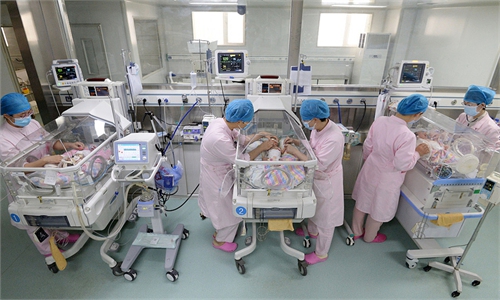China’s population highly likely to see negative growth for 2022 or 2023 at the latest: experts

Children dance in Zaozhuang, east China's Shandong Province, Oct. 1, 2022. (Photo by Sun Zhongzhe/Xinhua)
China's National Bureau of Statistics will soon release the country's population data for 2022. Population and economic experts predicted that China's population will see negative growth for 2022 or 2023 at the latest.
China's population grew by just 480,000 to 1.4126 billion in 2021, the lowest growth rate since 1962, and demographers say a national decline appears inevitable as the birth rate falls and people live longer, warning that China's population is approaching the warning line of negative growth.
China's total population size peaked in 2022, much earlier than expected, which means the country's population will see negative growth from 2023 or enter an era of negative growth after 2023, Cai Fang, former deputy director of the Chinese Academy of Social Sciences, said previously.
Yuan Xin, a professor at the Institute of Population and Development at Nankai University's School of Economics, said in 2022 that negative population growth is the inevitable result of the country's long-term low fertility rate, and China's population has entered an era of zero growth.
Birth data for 2021 released by 31 provinces and regions in China showed that 13 provinces had a negative population growth rate, and only six among the top 10 provinces had birth numbers exceeding 500,000 .
Among the 13 provinces, Jiangsu, Hubei, Hunan, Inner Mongolia, Shanxi and Tianjin recorded negative population growth for the first time in recent decades. In addition, Shandong and Anhui provinces are also on the verge of negative population growth.
India is set to surpass China as the world's most populous country in 2023, the UN projects. India was home to 1.417 billion people as of 2022, compared to China's 1.426 billion, according to the UN, noting that India's population continues to grow while China's population is expected to decline to 1.313 billion by 2050.
China implemented the third-child policy in May of 2021 and rolled out a series of stimulus measures to boost population growth. A number of cities or provinces across the country have rolled out incentive policies such as issuing subsidies to families with a second or third child.
The latest move by Shenzhen in South China's Guangdong Province has been to solicit public opinion on childcare subsidies. The subsidies for "third child" families can reach up to 19,000 yuan ($2,800) over the course of three years.
More than a dozen cities across China have implemented preferential housing policies since last May to encourage families with two or three children to buy more homes. The incentives include breaking the property-purchasing limit, and offering housing loans and subsidies.
However, China has entered a new era of negative population growth, which is an irreversible trend. The aging population has entered a deeper stage and will increase faster and faster in the future, which will pose new challenges for economic and social development.

